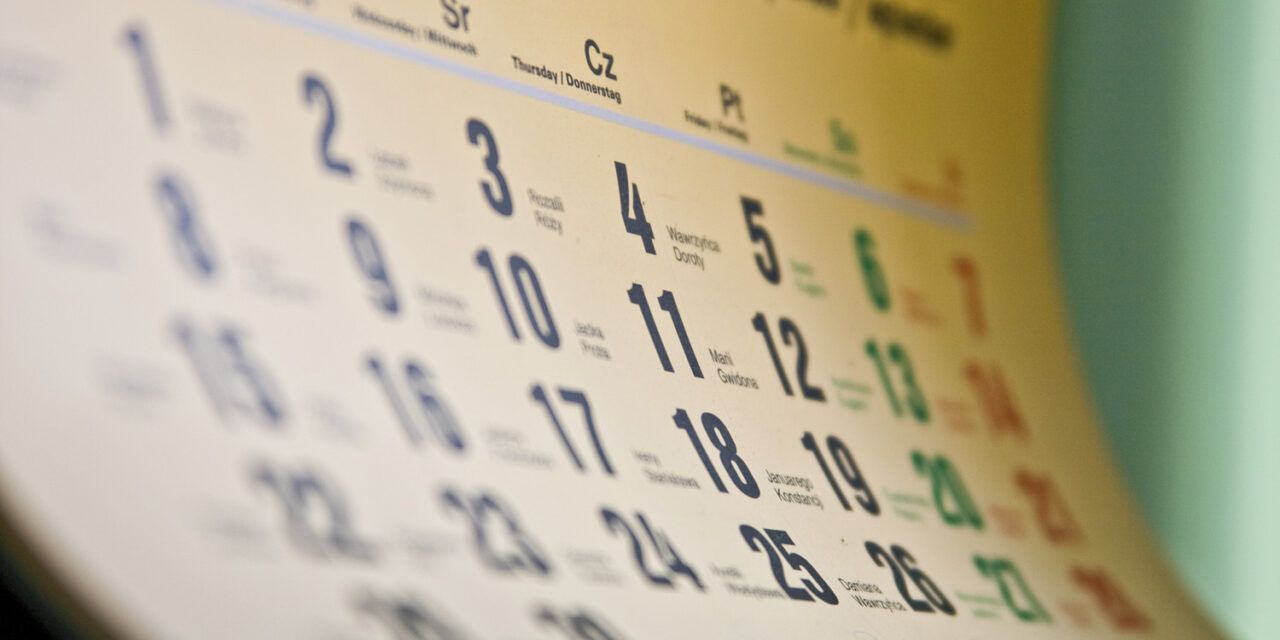The Polish Year – important calendar information for anyone doing business in Poland, in particular for HR and marketing departments.
[Note: 2024 is a leap year.]
Assuming no legislative change, shops will be open in 2024 on the following seven Sundays (niedziele handlowe):
28 January (winter sales)
24 March (last Sunday before Easter)
28 April (Sunday before the May public holidays)
30 June (summer sales)
25 August (last Sunday before the new school year)
15 December and 22 December (last two Sundays before Christmas)
(Public holidays marked in red; shops are also closed on these days.)
New Year’s Day (Monday)
Three Kings – 6 January (Saturday)
Three Kings (Trzech Króli) has been a public holiday since 2011 a public holiday. However, in introducing this additional day off work, the government announced that as a quid pro quo, any public holiday falling on a Sunday would no longer be replaced by days off in lieu. In 2024, this does not happen at all. However, public holidays, such as Trzech Króli, which fall on a Saturday, mean that employees can ask for a day off in lieu before or after.
Polish winter holidays (ferie) for 2024 – Monday 17 January to Sunday 27 February
The Polish education system has two semesters rather than three terms (trimesters) that the UK has; Christmas and Easter are shorter breaks than in the UK. There are no half terms (but then summer holidays are longer). Instead of half-term holidays, there are ferie – a single two-week break half-way through the school year, between the first and second semester. The ferie break occurs from mid-January to late-February, corresponding with the peak winter-sports season. To avoid overcrowded ski resorts, the ferie breaks are staggered voivodship (Polish province) by voivodship, and rotate each year. In 2024 the ferie breaks are like this:
| 15-28 Jan 2024 | Dolnośląskie, Mazowieckie, Opolskie, Zachodniopomorskie |
| 22 Jan – 4 Feb 2024 | Podlaskie, Warmińsko-Mazurskie |
| 29 Jan – 11 Feb 2024 | Lubelskie, Łódzkie, Podkarpackie, Pomorskie, Śląskie |
| 12-25 Feb 2024 | Kujawsko-Pomorskie, Lubuskie, Małopolskie, Świętokrzyskie, Wielkopolskie |
Finał WOŚP (Sunday 28 January)
The finale of the Wielka Orkiestra Świątecznej Pomocy, (‘Great Orchestra of Christmas Charity’) is Poland’s biggest flag-day-cum-telethon event, with volunteers shaking collecting boxes everywhere, for the 32nd time. The first was held in 1993. Each year, tens of millions of zlotys are donated (with new records being set each year) and passed onto children’s hospitals, and more recently, to old folks’ charities. Please give generously – Poland’s healthcare system took a heavy hit during the pandemic.
Carnival (7 January – 13 February)
Three Kings signals the traditional beginning of karnawał. While the Rio carnival or New Orleans’ Mardi Gras last but a few days, Poland has the longest carnival in the world – from 7 January right through to Shrove Tuesday (13 February in 2024), usually an ideal antidote to long, cold, dark nights, when spring is still a long, long way off. Because Easter falls early in 2024, in late March rather than in April, Carnival will be shorter than usual. Anyway, a time to party, to dance, to feast – for businesses, this is the ideal excuse for press launches, off-site staff events, mixers, mingles and anything else involving people, music, drink and a party atmosphere.
Last Party before the Exam Season
The studniówka, literally, “the Hundred Dayer” – is a ball that normally takes place a hundred days (or thereabouts) before high-school students take their matura, (equivalent of UK A-Levels – exams taken at the end of secondary education). A formal dance, gowns and suits, it’s the nearest Poland has to a High School Prom, but it’s held before the exams. Dates vary from school to school, on Saturdays in late January or February.
St Valentine’s Day – Wednesday 14 February
Walentynki, eagerly adopted by Poles ever since the free market took over from communism, clashes with Ash Wednesday, the first day of Lent, in 2024. Better luck next year!
Overdoing it before Lent I: – Tłusty Czwartek (Thursday 8 February)
While the rest of the Catholic world has Mardi Gras or ‘Fat Tuesday’, Poland has a ‘fat Thursday’ (tłusty czwartek) in the week preceding Shrove Tuesday, noted for the consumption of doughnuts (pączki). The last days of Carnival have begun.
Overdoing it before Lent II: – Ostatki (Tuesday 13 February)
Shrove Tuesday in Polish is Ostatki, literally ‘the Lasts’, or ‘that which is left’. Not content with bingeing on pączki on Fat Thursday, Poles also do Shrove Tuesday. Ostatki is the final, final fling before Lent, when the last of meat, cakes, ale, mead, vodka etc must be consumed.
Lent (Wednesday 14 February – 30 March)
From Ash Wednesday (or Popielec, falling on 14 February this year) to Easter Saturday (30 March). Taken more seriously than in the UK. Not a good time for product launches, office parties etc; many Poles will be giving up alcohol, cakes, confectionery, meat, dancing and loud music for the duration. Calendar Lent lasts 46 days. According to the Church however, it is 40 days, the difference being the Sundays, during which eating of meat, consumption of alcohol, etc, is permitted. [But given that the liver is the only human organ with the ability to regenerate, Lent is a great occasion to give up drink for the whole period, detoxify the body – and all in good time to get in shape for the beach.]
8 March: Dzień Kobiet – International Women’s Day
During the communist-era, a celebration which would be marked by female employees getting very, very drunk. Bosses would present secretaries with a pair of hard-to-obtain tights. Today, it is more of a celebration of feminism. Potted plants, daffodils (modern) or red carnations (traditional) are in evidence. Friday this year.
21 March: First Day of Spring
The first day of astronomical spring, when the sun crosses the equator and re-enters the Northern Hemisphere. Equinox. Celebrated in rural Poland with Topienie Marzanny (the drowning of Marzanna), in which a straw figure of a woman, dressed in white robes, symbolising Winter, is paraded around the village and thrown into the nearest river, pond or lake. This is also Dzień wagarowicza – traditionally ‘bunking off school day’; it falls on a Thursday in 2024. Weather-wise, the occasional snowfall has been known to happen in April and even early May, though such occurrences are becoming rare as the climate changes.
Last Weekend of March
Clocks go forward one hour at 02:00 on Easter Sunday 31 March, yielding a welcome extra hour of daylight in the evening. Suddenly, the sun sets in Warsaw at 19:03; a day earlier it was 18:01. At the same time, the UK will switch to British Summer Time, so Poland, on Central European Time, remains one hour ahead of the UK. There may still be anomalous weather, but generally, this is the time that drivers can replace their winter tyres with ordinary rubber. (At temperatures below +6C, normal tyres can lose grip on the road surface.) It’s always a close call as to when to change one’s winter tyres, but around the time the clocks change is a good rule of thumb. Perhaps the last time change? Who knows? No news from the European Parliament or European Commission on the proposal to stop the time change, despite overwhelming popular support across the EU.
Palm Sunday (24 March)
Church processions will be seen in the streets around churches; people will carry branches of willow (standing in for palms, generally unobtainable in Poland at this time of year!) to get blessed by the priests. Sunday 24 March is also one of the seven Sundays in 2024 when all shops are permitted to open (assuming no legislative changes in this regard).
Easter
Good Friday (29 March), Easter Saturday and Easter Sunday (31 March) are the culmination of the Roman Catholic year. Barely visible in the UK, yet taken most seriously in Poland. Shops are decorated accordingly (chicks, lambs, spring greenery). Paradoxically, Good Friday is not a public holiday in Poland – though it is in the UK. On Saturday, many people will go to their church to have a basket of food (traditionally a hard-boiled egg, some bread, salt and sausage) blessed by the priest. In larger towns there is also the tradition of going from church to church to visit the various Tombs of Jesus. Easter Sunday traditionally begins with the Resurrection Mass, which should begin before day-break, can last up to three hours, includes the singing of all 14 verses of the Te Deum and a litany to all the saints, burning of candles and incense and much ringing of bells and setting off of fire-crackers. At home afterwards, Easter is celebrated with a large breakfast meal, including much meat (sausages and hams, blessed the previous day, salads and the sharing of the symbolic egg). Schools will be closed from Thursday 28 March to Tuesday 2 April inclusive.
1 April – Easter Monday
The day after Easter Sunday, 1 April is a public holiday. Warning: It is also lany poniedziałek or śmigus dingus – the traditional Polish water-throwing festival, a rural fertility ritual, with young men chasing the girls with buckets of water drawn from the well. In towns, plastic bottles filled with water from puddles.
1 May – Wednesday
International Labour Day is marked with a day off work. Falling on a Wednesday, with Poland’s national day (3 May) falling on a Friday, many employees will take the Thursday off and enjoy a five-day break.
3 May – Friday
Trzeciego maja is a national holiday celebrating Poland’s first written constitution, back in 1791 – not too long after the US, making it the second in the world, the first in Europe. Usually coinciding with the first hot days of the year, a time to rejoice in sunshine by leaving town and communing with nature in forests, by lakes and rivers or walks through the blossoming countryside. National flags will be flown.
Zimni Ogrodnicy, Zimna Zośka 12-15 May
‘The Cold Gardeners’: St Pancras, (Pankracy – Sunday 12 May), St Servatus (Serwacy – Monday 13 May), St Boniface (Bonifacy – Tuesday 14 May) and St Sophia (Zofia – Wednesday 15 May). These four days are usually accompanied by a sudden cold snap after the first few weeks of beautiful spring weather; climate change has weakened this effect in recent years. The ‘Ice Saints’ are a Central European phenomenon, also noted in Germany and Czechia. Zofia’s name day is commonly celebrated by Zosias all over Poland.
First Holy Communion
Eight-year-olds will have their first Holy Communion throughout May and into June; traditionally an occasion to dress daughters in white dresses and to buy children bicycles – now increasingly tablets, laptops and smartphones. “Second-best time of year for sales of tech devices,” said one dealer, “after Christmas”.
Corpus Christi (Thursday 30 May)
A Holy Day of Obligation and a national holiday. A movable feast, always held on a Thursday, which means many staff will want to take Friday 31 May off to give them a four-day weekend. Large processions are held in many towns and villages around Poland, taking to the roads and visiting florally decorated wayside altars. Watch out for diversions and take special care when driving around in rural parts.
1 June – Children’s Day
Poles genuinely love their children. On Children’s Day, Poles buy them toys, take them on picnics or to the cinema. Many Polish firms will organise family picnics around this day. Warsaw’s Metro has celebrated the day by getting nursery school children to announce the names of the stations. The family is considered very important in Polish society, as are children. A Saturday in 2024.
Noc Świętojańska
Friday 21 June, St John’s Eve. The summer solstice, the longest day of the year, is traditionally celebrated coinciding as it nearly does with two Johns’ names-days (actually on 24 and 26 June). In rural Poland, Noc Świętojańska is celebrated by maidens casting floral wreaths into rivers, to be fished out by the man destined to marry the one who cast the wreath. Summer solstice comes this year on 21 June; the sun sets in Warsaw at 21:01. Make the most of the light evenings – in six months’ time, it will be dark before half past three in the afternoon.
End of the School Year
As stated above, Polish schools have two terms rather than three, with no half-terms and shorter Christmas and Easter breaks. However, they have longer summer holidays, breaking up at the end of June. This year, the school year officially ends on Friday 22 June. The last day of the school year is marked by ceremonies, diplomas, flower-giving, speeches, songs etc. Expect some parents of school-age children to ask for part of the day off.
30 June – Sunday
Shops are open today – one of the seven trading Sundays of 2024.
Summer holidays
Ten weeks between 22 June and 2 September. Assuming that all your staff and clients fall into that happy group of Poles able to afford a two-week holiday – and take it at this time – during any given time during this period you should theoretically still be able to find eight-ninths of staff behind their desks. However, new business is difficult – because two or more signatures are required on most pieces of paper, and most prezesi will be on foreign holidays, you may have to wait quite a while for that umowa to come back signed by the other party!
Remembering the Rising
80th Anniversary of the Warsaw Uprising, Thursday 1 August 2024
Warsaw is decked out in national and city (red-and-yellow) flags commemorating the outbreak of the Uprising on 1 August 1944. At precisely 17:00 – H-Hour – all the capital’s sirens sound. Time to contemplate the fact that over 200,000 civilians died (more than the number of Japanese killed by the combined atomic blasts at Hiroshima and Nagasaki) and that 85% of the city was destroyed in the two-month long effort to free the capital from the Nazis, while the Red Army watched on from across the river. This year the main commemorations will be held on a Tuesday
15 August (Thursday) – The Assumption/Armed Forces Day
The Assumption of the Blessed Virgin Mary. A public holiday. It’s also the national Armed Forces Day, marking the anniversary of the ‘Miracle on the Vistula’ (Cud nad Wisłą) of 1920, when the Polish army under Marshal Piłsudski saved Europe from the Bolsheviks sweeping westwards for Berlin and Paris. There will be a military march and a fly-past in Warsaw. Occurring on a Thursday, you can expect many people to take Friday 16 August off to have a four-day weekend.
25 August – Sunday
Shops are open on this, the last Sunday before the new school year begins.
New School Year, Monday 2 September
The Polish school year runs from the beginning of September to the end of the penultimate week of June. The first day is marked by formal school ceremonies, happening on a Monday. Parents of younger children will often ask for the morning off to attend.
Dożynki
The harvest festival, when garlanded politicians break bread with traditionally costumed peasants. Dożynki tend to take place from mid- to late-September. As good a time as any to sell consumer durables to Poland’s rural population, which still makes up one-third of the nation.
Last weekend of October
The clocks go back at 2am on Sunday 27 October. Suddenly, it’s dark shortly after 4pm. What we lose in the evenings, we gain in the mornings, but by mid-winter you will be setting off for work in darkness anyway. You won’t see much daylight outside of weekday working hours between now and late February. A good time to switch to winter tyres, as normal tyres’ grip starts deteriorating at around +6C. Will this be the last time the clock-change happens? Over to the EU…
1 November (Friday) – All Saints’ Day (Wszystkich Świętych)
A national holiday, with 80% of Poles visiting the graves of their departed family members. Cemeteries are ablaze with candles and votive lamps, bought in the preceding weeks in their tens of millions. The day often coincides with first frosts of the year, fogs and poor driving conditions just as half of Poland takes the road. Avoid large urban cemeteries (huge traffic jams). Take care driving, as the number of Poles killed in road accidents is higher than at any other time of year.
11 November (Monday) – Independence Day (Dzień Niepodległości)
This national holiday is usually celebrated with military parades, patriotic speeches and a day off work. National flags will be flown. Possibility of politically motivated clashes in city centres.
15 and 22 December (both Sundays)
The last two Sundays before Christmas are both open for trade.
Christmas (Święto Bożego Narodzenia)
Christmas Eve (Tuesday 24 December) – wigilia – is the Big Event, rather than the First Day of Christmas; however it is not a public holiday. Most employers, however, tend to give at least the afternoon off. The First Day and Second Days of Christmas (25 and 26 December) falling on a Wednesday and Thursday respectively, are both public holidays.
31 December (Tuesday) – Sylwestra – St Sylvester’s Eve – Polish New Year’s
Not a public holiday. Poland’s fireworks night, putting Guy Fawkes to shame. Not fun for pets or birds, however. The first day of 2025 falls on a Wednesday, which is a public holiday.
By Michael Dembinski, BPCC




























